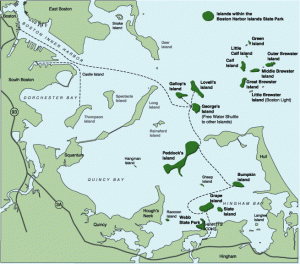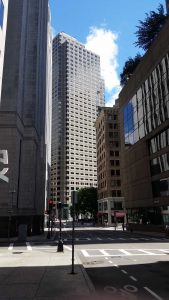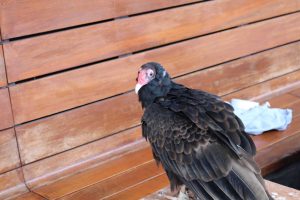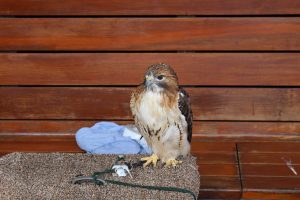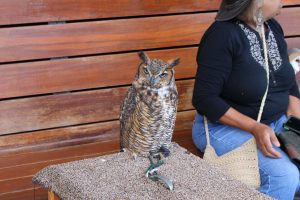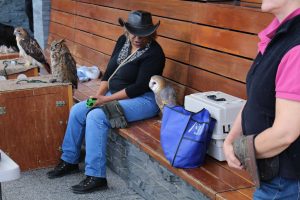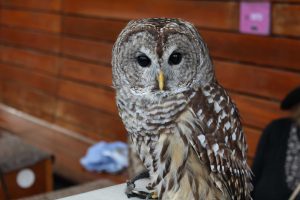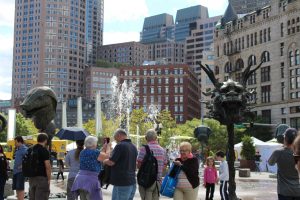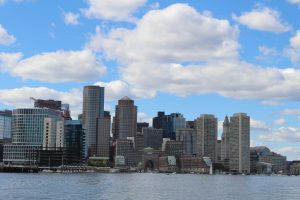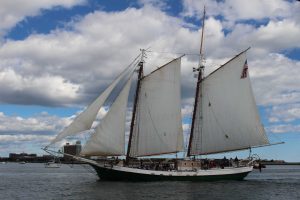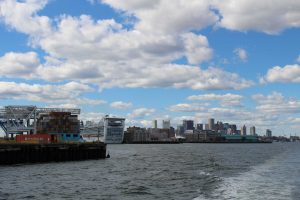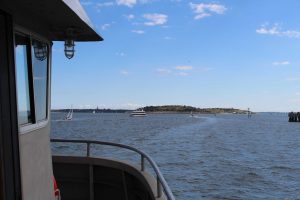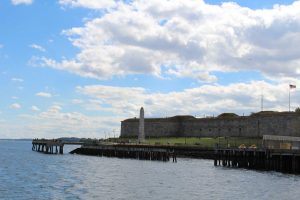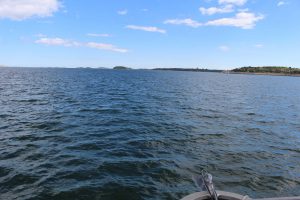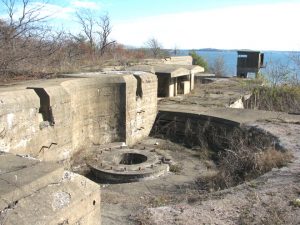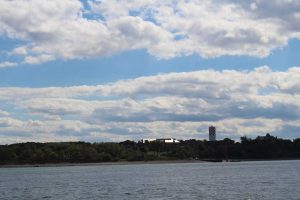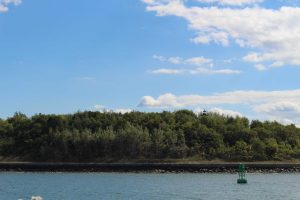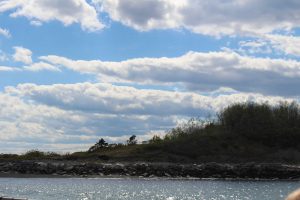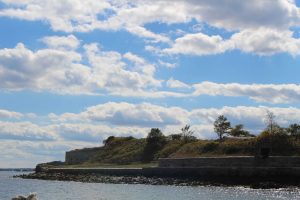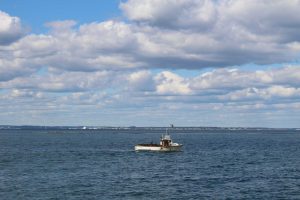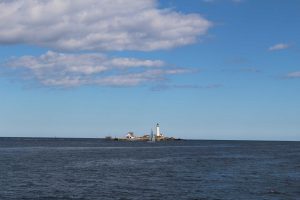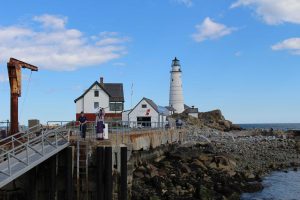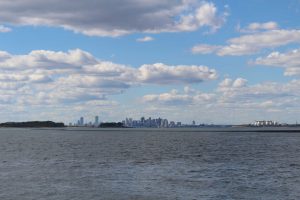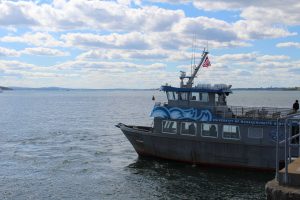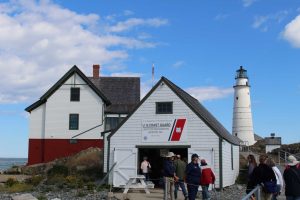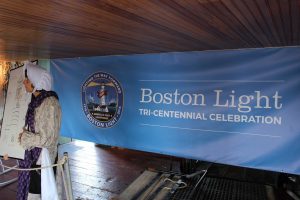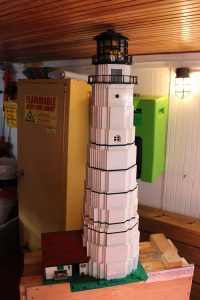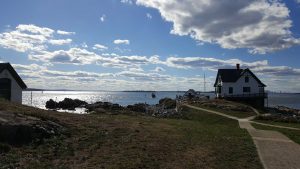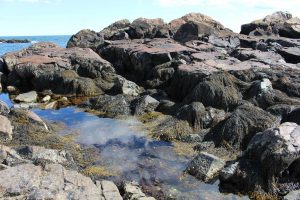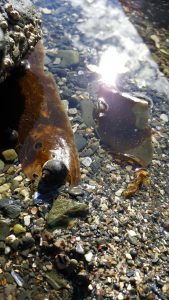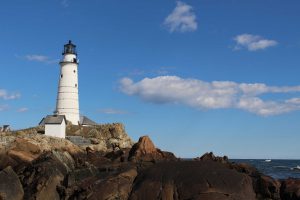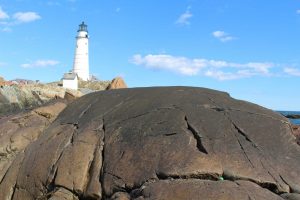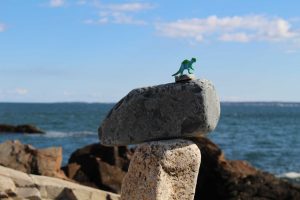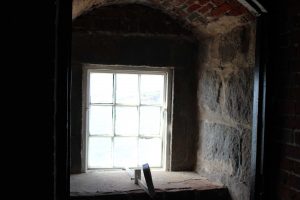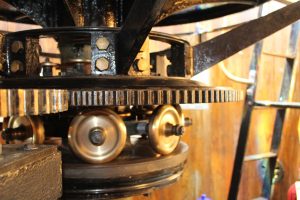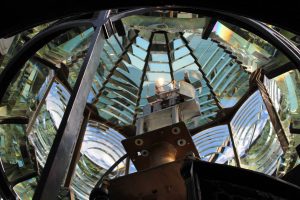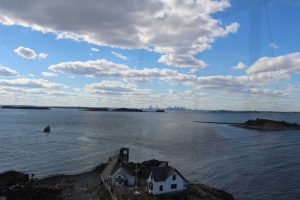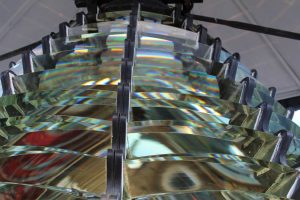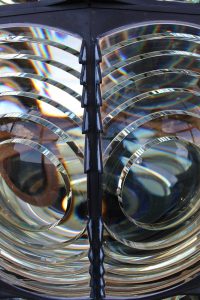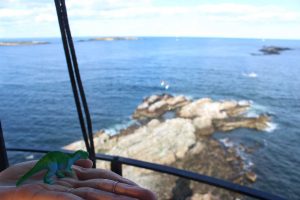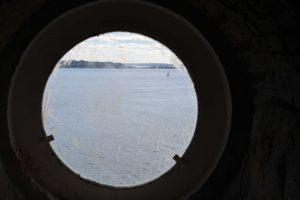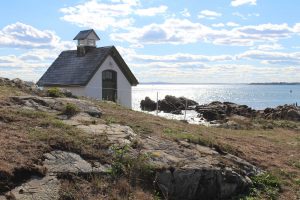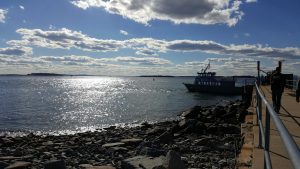Greetings,
On September 24th SB and I had a chance to celebrate a little piece of history by visiting the Boston Light. Now, before I get into just what the Boston Light is (spoiler: it’s a lighthouse), I have to first mention that we’d been planning this trip for quite some time. At some point – I’m not even sure when – we learned that the Boston Light was going to be celebrating its 300th anniversary during our tenure in Boston. So, being the kind of people to be interested in such a thing, we promptly added it to our Boston Bucket List where it joined other adventures such as Lexington & Concord, the Somerville “castle,” Castle Island, the Museum of Fine Arts, and Franklin Park Zoo (to name just a few of many things already accomplished, let alone those still yet to do). So to say we’ve been at least conceptually planning this little adventure for awhile is not a stretch and most of it was just waiting for the boat schedule to open up and in June it finally did.
So, since we’ve seen some classic New England lighthouses, what was our impetus for spending the better part of a Saturday going out to another one? Well, the answer is simple, the Boston Light is America’s Lighthouse (eagletears.jpg). More accurately, the Boston Light was the first lighthouse constructed in what would become the United States. Yep, this bad boy was first lit on September 14th, 1716, meaning that it’s 300 years old for those of you who are math disinclined and whose memory precludes them from remembering things they just read 20 seconds ago. In addition to being 300 years old, the Boston Light is also the last lighthouse in the entire country to be actively staffed by a lighthouse keeper (the rest are fully automated), but more on that in a bit.
History aside, just where is the Boston Light? Well, it’s in Boston Harbor – I can sense your surprise. More specifically, it’s located on Little Brewster Island, which is itself one of many islands located in the “Boston Harbor Islands National Recreation Area.” Here is a map showing the islands. I know I generally point things out with my Ph.D. level skills in Microsoft Paint, but this time around I think I’ll let you hunt for landmarks on your own, it can be your 10 seconds of adventure for the day.
The takeaway is that you need a boat to get to the Boston Light, or a lot of time and stamina for swimming. It’s not a “drive-up” coastal lighthouse. The good news is that the folks over at the National Park Service (probably my most favorite agency) realize that most people don’t have boats or the desire to swim 9 miles, so they decided to team up with the University of Massachusetts Boston to ferry people out there for money (read: they took UMass’s boat). This is what SB and I decided to do. We were going on a Saturday not only because of our own schedule (though SB works Saturdays now) but also because the schedule for the ferry is pretty restrictive as well. The downside of cool historical places is that showing people those places tends to result in people destroying them, so it’s a balancing act. SB took a half day at work and we decided to meet up at the departure point down near the harbor. The good news was that we got really lucky with the weather and it was a decently warm and mostly sunny day.
After getting myself temporarily lost in downtown Boston I found my way to the pseudo-Ranger Station located on the Rose Fitzgerald Kennedy Greenway. This brings me to the next cool thing about our trip, the BioBlitz. When we first booked our trip back in early June we had no idea that the one day we’d picked was a BioBlitz day for the islands – though to be fair I don’t even think they had planned it at that point. Regardless, unless you took the time to click that last link you’re probably wondering what a BioBlitz is. Well, to quote from the article you didn’t click, a BioBlitz is “an intense period of biological surveying in an attempt to record all the living species within a designated area.” In other words, people work together to document a bunch of creatures in a specific location; this time the BioBlitz was the Harbor Islands as a whole with Little Brewster Island being a focal point (BioBlitzes are occurring at most, if not all, NPS sites this year). The cool thing about this was that we got to help document things (or at least I did, SB was too cool for school) but more importantly, it also meant that there were some friends hanging out near the Ranger Station.
I got so infatuated with the birds I almost forgot to check us in for our trip (SB was running late and normally takes care of such human interactions, I prefer birds that want to eat my face).
First up was Svend Borchmann Hersleb, the turkey vulture.
Svend likes consuming dead things and rising in revolt against his captors, in his free time he pillages English villages.
Next up is Gregory of Utrecht, the red-tailed hawk.
Gregory likes bringing terror to rodentia villages and sharpening his talons, in his free time he likes to practice with his a cappella group the Accipitrinaes.
Next is William Henry Vanderbilt, the great horned owl.
William likes acting philanthropic and reading tomes about capitalism, in his free time he likes laughing at the common-folk.
The next fellow is Leopold Stokowski, the barn owl.
Leopold is shy by nature and likes crawling into corners, in his free time he composes and conducts symphony orchestras.
Finally we have Fengxian, the barred owl.
Fengxian used to be a warrior, but now he prefers peace and quiet, in his free time he likes the seemingly contradictory pastimes of betraying warlords and avoiding dishonor.
Once SB arrived and we spent some time with the bird friends the Park Rangers then gathered us up for a safety meeting and then led us down to the boat at the harbor. Along the way we noticed that the area was really bumping. Not only was there a market and festival of some sort going on there were also several cruise ships in port, and you know how those cruise people are. We also noticed a display of several animal heads (fictional and nonfictional) around a fountain, neither SB or I could remember seeing them before, so they must be new(ish).
From there it was just a quick jaunt down to the harbor where we boarded our vessel and were underway!
We even passed a clipper just a short ways out from the dock. Judging from the number of people I’m guessing it’s a tour boat, though some of the clippers in the area are still used for their original purposes.
As we got out closer to the freight areas we spotted a bunch of the cruise ships.
From there we started getting out into the more “open” harbor area.
One of the first big landmarks we passed was Fort Independence. This was the first time we’d seen it from the water.
As mentioned, it was a pretty spectacular day. It was cool, but not cold and it was sunny, but not oppressively so. It’s easy to get both sunburn and windburn out on the water, but this time I managed to sneak away with just some windburn on my lips. Of course I probably make that worse by insisting on being at the very front of the boat most of the time.
The next landmark was Long Island (MA, not NY, putting a Bostonian lighthouse in NYC would be weird – and pointless). Long Island has kind of a cool history, it’s served as a military fortification during various conflicts as far back as the American Civil War. In fact, some of the turn of the 19th century fortifications, from Fort Strong, are still visible on the island. In fact, many of Boston Harbor’s fortifications are still present, albeit in various stages of disrepair. Credit for these two photos goes to Wikipedia user “Pgrig.”
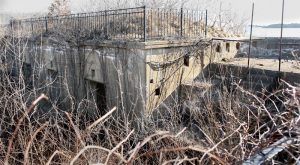
However, what brings Long Island into a more contemporary consciousness are the buildings from the old almshouse, chronic disease hospital, and asylum. Some of the facilities can be seen below.
The reason that matters is that these old Long Island facilities were the basis for Dennis Lehane’s novel “Shutter Island” which you probably recognize from the 2010 film of the same name which is based on said novel. Lehane visited the island as child with is family during the Blizzard of 1978 and felt haunted by the surroundings, thus planting the seeds for what would eventually become Shutter Island. So, if you haven’t seen the film you really should, I thoroughly enjoyed it and really need to read the book. Either way, it’s kind of cool seeing the “real” Shutter Island.
Here’s another shot of Long Island, including the island’s old lighthouse nestled among the trees.
Our next landmark, Nixes Mate, also had a touch of macabre too it, namely because it was were Boston gibbeted all the pirates they captured and executed.
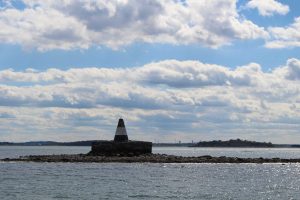
“Welcome to Boston, where we will kill your ass and then hang your body for seagulls to eat. Enjoy your stay.”
If you’re thinking that the island looks a little small for all those dead pirates, then you wouldn’t be mistaken. According to the Ranger on our boat Nixes Mate used to be 12 acres, but has since eroded away to what you see above. Now, I have to say that Nixes Mate refers to the island, not that black and white daybeacon you see in the middle. I thought Nixes Mate was the daybeacon, but nope, it’s the island – what little is left of it. The daybeacon is actually part of the National Register of Historic Places as of 2004 and dates back to 1805. The legend behind the name of “Nixes Mate” is kind of interesting. Supposedly there was once a ship-captain, named Captain Nix who was murdered at sea and apparently had no first name. The primate suspect was his first mate who apparently had no name at all. Nix’s Mate (Nixes Mate – get it now?) was ordered to be hung for the murder of Captain Nix, however he pleaded that he wasn’t guilty to end and in the final moments before he was put to death he declared that the island would sink to prove his innocence. Whelp, as you can tell, the island has indeed “sank” which kind of means that ole Nix’s Mate was indeed innocent and Boston was all like “whoops.”
The next island we passed was Gallops Island, named for a harbor pilot who lived on the island many, many, many years ago. Gallops island has no dark history, but it did serve as staging camp for over 3,000 Union soldiers during the Civil War, and also served as the debriefing and disembarkation stop for Union soldiers returning from the war.
The one sort-of funny thing about Gallops Island is that you can no longer visit it because its like covered in asbestos from a bunch of stuff the military left behind. It’s supposed to be reopened at some point, but I think a lack of cleanup funding is holding up progress.
Next up was Georges Island, which houses the remains of Fort Warren – the “fore-fort” at the entrance of Boston Harbor which was an active fort until 1947.
Fort Warren was named after Dr. Jospeh Warren, of Revolutionary War fame (he sent Paul Revere on his famous ride and also served – and was killed – at the Battle of Bunker Hill). In addition to serving as the foremost of Boston’s extensive coastal defense system Fort Warren also served as a military prison during the Civil War, housing famous Confederates such as Vice President of the U.S.C., Alexander Stephens.
After passing Georges Island by we got into some open water where some fishermen were taking advantage of the relatively calm waters that day.
Soon enough Boston Light itself came into view!
Once we got close to the shore of Little Brewster Island we were created by NPS staff, Coast Guard staff, and of course, Sally Snowman, the current keeper of Boston Light. I don’t think you’ll struggle to figure out who Sally is in this photo.
In case you were wondering where we were in relation to Boston proper, then this next photo gives you a pretty good idea of how far out we’d gone.
Once docked we left our UMass boat behind..
..and headed up into the Coast Guard’s old boathouse for our formal welcome to the island.
Here Sally explained the history of the island and the lighthouse and also introduced us to the various people who would be scattered around the island to assist us and teach us things.
Which brings us to Little Brewster Island and the Boston Light themselves.
Little Brewster Island, as you might has guessed, is an island in the “Brewster cluster.” Little Brewster’s island siblings include Great Brewster, Middle Brewster, and Outer Brewster. All of the Brewsters are named for William Brewster, a Mayflower passenger and the first teacher in the Plymouth Colony. The cluster of islands once housed the Brewster Islands Military Reservation, thought that was decommissioned in 1947 after the end of WWII. However, Little Brewster Island is still an active Coast Guard facility due to the Boston Light, which is why the schedule to visit it is so restrictive.
Now, if you are really up on your military history, you might be thinking “But the Coast Guard didn’t exist until 1790!” Well, that’s true, but the Coast Guard wasn’t originally responsible for the Boston Light, or any lighthouse for that matter – that duty originally fell to the United States Lighthouse Board, which was succeeded by the United States Lighthouse Service, which was itself rolled into the United State Coast Guard in 1939. Of course the Lighthouse Board didn’t exist until 1791, which mean that during the earliest years of its life the Boston Light was ran entirely by the municipality and private parties. However, after that lengthy history the Boston Light now finds itself in the hands of the Coast Guard, including its current keeper, Sally Snowman, who is herself a member of the Coast Guard Auxiliary forces. Sally is the 70th keeper of the Boston Light, and as she likes to point out, the first 69 of them were men, making her the first female keeper in the light’s extensive history. Pretty cool. The Boston Light is the last lighthouse left in the United States with an constant, live-in keeper as all the others have been fully automated by this point. In fact, whether they like or not the Coast Guard has to maintain a keeper in the Boston Light “for perpetuity” due to an 1989 act of Congress. The Boston Light is also, if it wasn’t obvious, the oldest “beacon” in the Coast Guard Aids to Navigation System, which in the past 300 years has expanded from the sole Boston Light to over 48,000 federal buoys, beacons, and electronic aids along more than 25,000 miles of the federal Maritime Transportation System.
Anyways, the historian in me has to point out that the light hasn’t been continuously lit since September 14th, 1716, nor has the keeper job always been as pleasant as greeting tourists – in fact, the very first keeper, George Worthylake, and his entire family drowned while attempting to return to the light one evening, making the first keeper the first “Coast Guard” to die in duty as well – great start. As for the light itself, in 1774 those pesky British folks took the island over and by 1775 had blockaded the entire harbor. Because we didn’t much care for that, we sent a group of soldiers to burn down our own lighthouse in the hopes that maybe some British ships would crash or something, or maybe we were just emo raging. Well, we didn’t manage to destroy it, just damage it quite a bit. We even tried to burn it again and did more damage, but still didn’t destroy it – though we did fight the British over it three more times. Eventually, in 1776, the British decided to leave Boston and let them have their baked beans or whatever it was they wanted. However, as a parting gift they left a time charge inside the lighthouse and blew the entire thing to hell. Hope for those guys’ sake God isn’t a Lighthouse Lover. Now, part of the lighthouse was still there, namely the foundation, which kind of just sat out there for a few years all sad and depressed looking.
However, by 1783 Massachusetts decided that they should probably rebuild the Boston Light because ships had this nasty habit of running into islands without it, and you know when a ship hits an island the entire crew has this inconvenient tendency to die and take all the cargo with them. So, that same year they rebuilt the Boston Light. In 1790 they turned it over to the Federal Government so they could pay to keep the bird poo off of it. During the War of 1812 the Boston Light saw action again, but this time around the British didn’t blow it up nor did the Americans try to burn their own light house down again, so it survived that war unscathed. In 1856 the Boston Light was raised up to 98′ from 75′ after ships kept suiciding themselves on rocks. After that the Boston Light just chilled and did its lighthouse thang’ until World War II rolled around, and the Feds decided to extinguish the light for security reasons (because everyone knows that the Nazis hated lighthouses). However, it was returned to operation on July 2, 1945 and the ships promptly stopped suiciding themselves again. And other than receiving a system upgrade in 1998, and some major renovations in 2014 (in preparation for its tricentennial), all has been pretty constant with the ole’ Boston Light since then.
One such constant (since a lake of crumpets caused British rage anyways) has been the Boston Light’s Fresnel Lens, but I’ll talk more about that in a moment.
Back to the present, once Sally was done briefing us on how not to slip and die on the rocks we were all sent in various directions based on the color of our wristband. SB and I were Green (much to Tristen’s joy) which meant we had a little bit before we headed up the lighthouse. There were 5 groups during our visit – Red, Orange, Yellow, Green, Blue though they can take up to 7 groups (Indigo and Violet as the extras) which you’ll probably recognize as the colors of the rainbow. Each group is limited to 8 people per Coast Guard regulations (space is limited in the light) but somehow our group ended up with 9 people (but the NPS people kept that as our little secret from the Coast Guard people).
So our first order of business was to get our NPS stamps in the boathouse (we actually got 3 that day, 1 at Boston Harbor, 1 for Little Brewster Island, and 1 big 300th Anniversary one for the Boston Light). In addition to some historical artifacts the boathouse also had a cool Lego replica of the light.
From the boathouse we headed down to the shore of Brewster Island where some graduate students from Umass were assisting people with the BioBlitz.
It was quite slippery and rocky down there, but there were lots of buddies – both big and small.
Most of what we were looking for was in the little tidal pools, which aren’t too hard to find given Little Brewster’s intertidal zone of 4 acres.
Using the free app I’d downloaded, “iNaturalist,” I was able to help find various little critters and tag them for digital examination. I found an itty-bitty crab and also a seas-nail before we were called up to the lighthouse.
Here is a good shot of where we were on the island in reference to the Boston Light itself.
On the ferry ride over I noticed that I had a stowaway with me. Can you spot him in this photo?
Yes, Pigsten is not one to miss anything that involves an opportunity to dig and explore rocks.
In fact, before we left the island Pigsten had chosen a “brick red” rock for his collection – which was fitting for Boston – seen below with his Alaska rocks.
Once called to go up the light, and after getting some more history lessons and waiting for the last group to descend, we started making our way up.
As you progress up the 76 steps to the top your first stop is in the “gear room” which is exactly what it sounds like, a gear room. You have to climb the first of two ladders to get into the gear room.
The gear room is pretty cramped, as is the entire lighthouse. In fact it’s so cramped that you have to progress through the room in two stages, it can’t hold a full group at once. However, because SB and I were the youngest people of all the groups (I am noticing this odd pattern where SB and I seem to not do things other young people do, lol) we got up there way before the rest of the people in our group who were busy trying not to die on the stairs. So we got to proceed up the second ladder and have the light room all to ourselves (and Pigsten) for just a little bit, which was nice.
In addition to being like 2 billion degrees in the light room (despite being a breezy September day at the mouth of a harbor) it was also gorgeous up there. He is a photo looking back towards Boston.
And here is a shot looking out to sea – if you look closely you might even seen a U-boat where the Nazis have been waiting for 70 years with baited breath and parched lips for the opportunity to destroy the lighthouse.
Now, despite the views the real centerpiece (both literally and figuratively) of the light room was the Boston Light itself, which happens to be a Second Order Fresnel Lens.
This lens was installed in 1859 and is only Second Order Fresnel Lens still in operation in Massachusetts. If you were wondering, the “Order” had to do with the size of the lens. For example, a Second Order Lens was larger than a Fifth Order Lens, and a Fifth larger than a Seventh, etc.
If you happened to enlarge either of those two photos above then you may have noticed some damage to the lens. You can thank careless people for that. Since oh so many people can’t resist touching and/or destroying everything they come in contact with, a lot of people ignore the repeated orders not to touch the lens and proceed to touch it all over the place. When this happens they leave behind skin oil, which in turn heats up on the glass and causes it to chip and crack. So the fact that those damaged spots above just to happen to be about the size of a finger poke is not coincidence. Of course they don’t make Fresnel Lenses like this anymore, or even replacement parts for them. Even if you could replace the lens it’s estimated that it would cost around 10.4 million dollars. Yep 10.4 million. So when it gets damaged, it’s pretty much damaged until someone wants to put forth enough money to not only build a new lens, but also re-develop the process (e.g. the Coast Guard is never going to do that). So the moral of the story is don’t be a Scott Tenormann and keep your damn fingers off the lens.
On a lighter note, Pigsten thoroughly enjoyed the views and warmth of the room (and didn’t touch the lens either).
After awhile up top we headed back down.
Right as we got out of the lighthouse SB got a call from work, so while she was dealing with that Pigsten and I took it upon ourselves to explore the island a bit more.
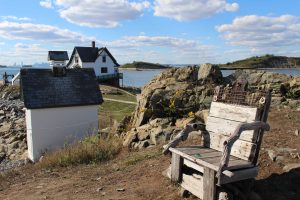
Pigsten – Lord of Little Brewster Island
We spoke to one of the Coast Guard folks about the history of the island and learned a bit more about the Coast Guard’s oldest artifact in the entire country, which turns out to be the Boston’s Light’s old signal/fog cannon from 298 years ago (seriously), though the cannon itself is believed to be 316 years old.
From there we just wondered around a bit and took in the wonderful afternoon.
It was surprisingly nice on the island. Generally speaking the wind is crazy in Boston Harbor, but today it was fairly mellow for us.
Once SB was done on the phone we got a passerby to take a photo of us with the lighthouse and 300th birthday “frame.”
After that it was about time to head back into Boston proper.
As we pulled away from Little Brewster Island SB and I broke out some snacks and prepare for a peaceful sail home, well, at least mostly peaceful – we ended up hitting a few pretty damn big waves on the way back.
Once safely back in port we headed home before going grocery shopping and then settling in for the evening, all in all an amazing Saturday!
I was really glad that we were able to help the Boston Light celebrate its 300th anniversary, especially considering the minor incident of it being blown up and all. I also liked that our ticket prices went to the NPS rather than some private tour company. But, more than anything, I appreciated the opportunity to learn more about our first lighthouse. It’s kind of amazing the history some places have if you just stop and smell the flowers – and yes, there were even flowers on Little Brewster Island! The flowers are mostly thanks to Sally, and as a closing note, you should read this really cool piece about Boston Light’s most recent keeper.
I could see myself as a lighthouse keeper, but it doesn’t sound like the job market is too friendly these days. But hey, a guy can dream.
Until next time,
-Taco
